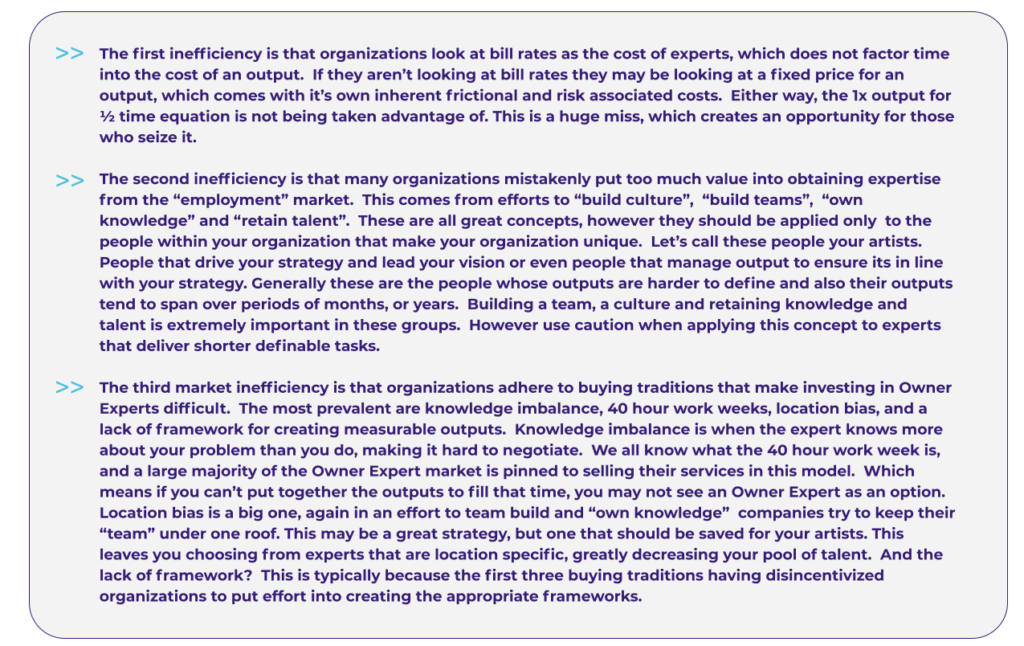
Written by: Matthew Carswell
It’s no secret that there is a crunch for talent when it comes to IT and Digital expertise. The ability to appropriately obtain and retain the expertise needed to remain competitive can make or break a business. This is especially true in industries that are experiencing disruption from technology. And let’s be real, what industry isn’t?
It’s a legitimate struggle. Choosing the right technologies that will keep your business competitive is difficult, and that choice is compounded by the uncertainty involved in getting the talent needed to make the technology relevant to your business.
Enter the Expert Arbitrage. For those of you that aren’t familiar with the term arbitrage, it refers to a trade or deal that allows the buyer to take advantage of a price difference between two markets. For example, if you could buy an ounce of gold for $1000 in one country, and sell it for $1100 in another. In theory, you could do this risk free all day and make a fortune. There are small arbitrages that take place all around us all the time. In economic theory, in a perfectly efficient market arbitrage does not exist. Only inefficiencies in a market can create these highly advantageous opportunities.
The Expert Arbitrage is one of those. It’s actually a simple concept. If you have an expert that can produce twice the output of someone with the same skill set, whose cost is only double that of the non-expert. Invest in the expert, every, single, time.
This equation (Expert cost)(Output)(Time)< (Non-expert cost)(Output)(Time) is powerful on it’s own. Say you have 10 deliverables, an expert can deliver them in 20 hours, and a non-expert can deliver them in 40 hours. Assume that time is a commodity and that it has a definable cost. Also assume the hourly dollar cost of the expert is double, so the total dollar cost would be the same at let’s say $100 total. The equation would look like this: (10)(20)(100) for the expert, which makes your cost combined time and dollar cost 20,000 “Time Dollars”. The non-expert would be (10)(40)(100), which totals 40,000 “Time Dollars”. So, if you think time is either the same or more valuable than money, than you are getting the deliverables at half price every time!
Making the case on pure output alone is easy, but it’s only the tip of the iceberg. Getting the same output done in half the time delivers a massive return in the form of an opportunity cost. What improvements can you make when you get deliverables in half the time for the same cost? Maybe that’s when you create something extraordinary.
Ok, reality check time. I know what you are thinking. If you think like I do, you may be thinking “Yeah that makes sense buddy, but one problem, where are all these experts that can produce double the output? They don’t grow on trees. And even if they are out there, how can you know they can produce that much beforehand so that you can trust them with the work?” I hope you are asking that! Because that extremely valid question leads us to the market inefficiencies that have created the Expert Arbitrage.
It’s not complicated. A much higher percentage of the experts with at least 2x output are outside the “employment” market. The expert to non-expert ratio is probably around 1 to 10 in the employment ranks, where as it’s probably nearly a complete flip flop in the non-employed market. This market of freelancers, sole proprietors, contractors, etc. which we call “Owner Experts”. These people are often self-employed and have gotten so good at what they do, they can demand double the dollars. And there are many, many of them out there that do. But remember, when you factor time in, that means you are getting those outputs for half the cost!
Ahhhh, now we’ve come to the market inefficiencies. The lovely holes in the market that allow you to take advantage of this arbitrage. Here are the three factors in the market that allow these inefficiencies to persist:

So there we have it. Describing the inefficiencies that create the Expert Arbitrage have led us to reveal value in the experts that make up the rest of that iceberg I was talking about. There really is an entire iceberg of value underneath! Here’s the basics:
So now that we have filled out the rest of the iceberg, using a positive or negative multiplier based on the benefits received, you might venture to say the equation is actually something more akin to the below. Yes, this a highly theoretical attempt at estimating a total cost of ownership. Humour me.
| (Expert Cost) | 2000 |
| (Output) | 10 |
| (Time) | 0.5 |
| (Cost Alignment) | 0.9 |
| (Retention) | 0.8 |
| (Engagement) | 0.8 |
| (Cross-Pollination) | 0.9 |
| (Tech Pivot) | 0.8 |
| Theoretical Total | $4,147.20 |
| (Non-expert cost) | 2000 |
| (Output) | 10 |
| (Time) | 1 |
| (Cost Alignment) | 1.2 |
| (Retention) | 1.2 |
| (Engagement) | 1.2 |
| (Cross-Pollination) | 1.1 |
| (Tech Pivot) | 1.1 |
| Theoretical Total | $41,817.60 |
So there it is. The Expert Arbitrage is a hole in the market that has the potential to deliver 10x productivity to your organization. If it isn’t 10x, what is it? That’s for you to find out. What can be done with more productivity is only inhibited by your artists and your vision. Don’t let the Expert Arbitrage slip through your fingertips. Your competition may be using it against you as we speak.